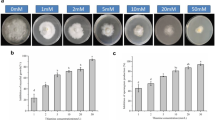Abstract
Pretreatment of Nicotiana tabacum with acetylsalicylic acid and β-ionone reduced the severity of symptoms caused by the black shank pathogen, Phytophthora parasitica var, nicotianae, and tobacco necrosis virus (TNV). Acetylsalicylic acid applied as root drenches or leaf injections (1.1 mM) reduced symptom severity following challenge with either pathogen, but foliar sprays were ineffective. β-ionone was most effective when applied neat as leaf injections or as drops to leaf axils at least 2 weeks before challenge. Phloem injections were no more effective than control injections with water, but induced localised wounding, an increase in the number of leaves, and precocious flowering. Root drenches of 2 mM β-ionone significantly reduced the number and size of lesions induced by TNV, but were no more effective against P. parasitica var. nicotianae than control drenches of Tween 20. Both β-ionone and acetylsalicylic acid inhibit the growth in vitro of P. parasitica var. nicotianae at the concentrations used. Differences in the characteristics and persistence of the protection afforded by β-ionone and acetylsalicylic acid suggest different modes of action.
Similar content being viewed by others
References
Antoniw, J.F. and White R.F. (1980) — The effects of aspirin and polyacrylic acid on soluble leaf proteins and resistance to virus infection in five cultivars of tobacco. Phytopathologische Zeitschnift 98:331–341.
Chen, Z., Silva, H. and Klessig, D.F. (1993) -Active oxygen species in the induction of plant systemic acquired resistance by salicylic acid. Science 262:1883–1886.
Edelbaum, O., Ilan N., Grafi, G., Sher, N., Stram, Y., Novick, D., Tal, N., Sela, I. and Rubinstein, M. (1990) — Antiviral proteins from tobacco: Purification and characterisation by monoclonal antibodies to human β-interferon. Proceedings of the National Academy ofsciences, USA 87: 588–592.
Edelbaum, O., Sher, N., Rubinstein, M., Novick, D., Tal, N., Moyer, M., Ward, E., Ryals, J., and Sela, I. (1991) — Two antiviral proteins, gp35 and gp22, correspond to β-1,3-glucanase and an isoform of PR5. Plant Molecular Biology 17:171–173,
Enyedi, A.J., Yalpani, N., Silverman, P. and Raskin, I. (1992) — Signal molecules in systemic plant resistance to pathogens and pests. Cell 70 879–896.
Isoe, S., Hyeon, S.B. and Sakan, T. (1969) — Photooxygenation of carotenoids. I. The formation of dihydroactinidiolide and β-ionone from β-carotene. Tetrahedron Letters 22:279–281.
Linthorst, H.J.M. (1991) — Pathogenesis-related proteins of plants. Critical Reviews in Plant Science 10:123–150.
Malamy, J. and Klessig, D.F. (1992) — Salicylic acid and plant disease resistance. The Plant Journal 2:643–654.
Mauch. F., Mauch-Mani, B., and Boller, T. (1988) — Antifungal hydrolases in pea tissue. 11. Inhibition of fungal growth by combinations of chitinase and β-1,3-glucanase. Plant Physiology 88:936–942.
Nemestothy, G.S. and Guest, D.I. (1990) — Phytoalexin biosynthesis, phenylalanine ammonia lyase activity and ethylene biosynthesis in fosetyl-A1 treated resistant and susceptible tobacco cultivars infected with Phytophthora itnicotianae var. nicotianae. Physiological and Molecular Plant Pathology 37:207–219.
Palva T.K., Hurtig M., Saindrenan P, and Palva E.T (1994) — Salicylic acid induced resistance to Erwinia carotovora subsp, carotovora in tobacco. MolecularPlant-Microbe Interactions 7:356–363.
Pennazio S., Roggero P. and Gentile I.A. (1985) — Effects of salicylate on virus-infected tobacco plants, Phytopathologische Zeitschnift 114:203–213.
Raskin, I. (1992) — Role of salicylic acid in plants. Annual Review of Plant Physiology and Plant Molecular Biology 43:439–463.
Roberts, D.A. (1984) — Comparison of lesion size and number as criteria of virus-induced systemic acquired resistance in hypersensitive plants. Phytopathologische Zeitschnift 110:272–276,
Salt, S.D., Tuzun, S. and Kuć, J. (1986) — Effects of β-ionone and abscisic acid on the growth of tobacco and resistance to blue mould. Mimicry of effects of stem infection by Peronospora tabacina. Physiological and Molecular Plant Pathology 28:287–297.
Sutherland, M.W. (1991) — The generation of oxygen radicals during host plant responses to infection. Physiological and Molecular Plant Pathology 39:79–93.
Van Loon, LC. (1983) — The induction of pathogenesis-related proteins by pathogens and specific chemicals. Netherlands Journal of plant Pathology 89:265–273.
Van Loon, L.C. (1985) — Pathogenesis-related proteins. Plant Molecular Biology 4: 111–116.
Ward, E.R., Uknes, S. J., Williams, S.C, Dincher, S.S., Wiederhold, D.L., Alexander, D.C., Ahl-Goy, P., Metraux, J.P. and Ryals, J.A. (1991) — Coordinate gene activity in response to agents that induce systemic acquired resistance. Plant Cell 3: 1085–1094.
White, R.F. (1979) — Acetylsalicylic acid (aspirin) induces resistance to tobacco mosaic virus in tobacco. Virology 99:410–412.
Yalpani, N., Silverman, P., Wilson, T.M.A., Kleier, D.A. and Raskin, I. (1991) — Salicylic acid is a systemic signal and an inducer of pathogenesis-related proteins in virus-infected tobacco. Plant Cell 3:809–818.
Ye, X.S., Pan, S.Q. and Kuć, J. (1989) — Pathogenesisrelated proteins and systemic resistance to blue mould and tobacco mosaic virus induced by tobacco mosaic virus, Peronospora tabacina and aspirin. Physiologicaland Molecular Plant Pathology 35: 161–175.
Author information
Authors and Affiliations
Rights and permissions
About this article
Cite this article
Dennis, J.J.C., Guest, D.I. Acetylsalicylic acid and β-ionone decrease the susceptibility of tobacco to tobacco necrosis virus and Phytophthora parasitica var. nicotianae . Australasian Plant Pathology 24, 57–64 (1995). https://doi.org/10.1071/APP9950057
Received:
Accepted:
Issue Date:
DOI: https://doi.org/10.1071/APP9950057




